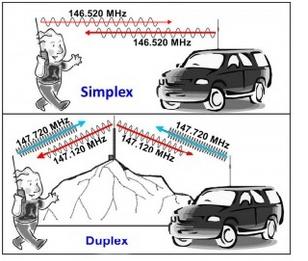 |
 |
 |
| |
|
|
| |
    |
|
| |
|
|
| |
Welcome to Ham Radio School |
|
| |
|
|
| |
Simplex, Duplex,
Offset and Split |
|
| |
|
|
| |
Some time ago, a ham on
twitter posted about a “2m SSB simplex contact” he had made.
Another ham replied
with “2m SSB is just that. The word simplex is not needed.”
The second ham is
incorrect…not all 2m SSB contacts are simplex.
Most of them are but
not all.
More importantly, I
think this exchange highlights some common confusion about terms such as
simplex, duplex and repeater operation. |
|
| |
|
|
| |
Terminology |
|
| |
|
|
| |
Simplex
– In the amateur radio context, simplex operation means the radio
stations are communicating with each other directly, on the same
frequency. Both stations take turns transmitting and receiving on the
same frequency with no repeater or other device in between. |
|
| |
|
|
| |
Duplex
– Duplex operation means that a radio station transmits on one frequency
and receives on a different frequency. |
|
| |
|
|
| |
Full Duplex
– Operating duplex with the ability to transmit and receive
simultaneously. |
|
| |
|
|
| |
Half Duplex
– Operating duplex but having to switch between transmit and receive |
|
| |
|
|
| |
Repeaters
[simplex,
duplex] |
|
| |
 |
|
| |
Examples of simplex vs.
duplex operations. The repeater station (lower image, on mountain) is
full duplex, instantly retransmitting a received signal. Each user’s
station is half duplex, unable to transmit and receive simultaneously,
but shifting between the transmit and receive frequencies. |
|
| |
|
|
| |
FM repeater operation uses
two frequencies: the repeater receive frequency and the repeater
transmit frequency. The repeater’s job is to take the signal it hears on
its receiver and retransmit it on the transmit frequency. See this
article for more information on how repeaters work. Repeaters operate
in full duplex mode, because they receive and transmit at the same time.
The repeater user is usually operating in half duplex, using two
frequencies but switching between transmit and receive. Some FM ham
radio gear can operate in full duplex mode (usually employing two
different ham bands) but most equipment is half duplex only. |
|
| |
|
|
| |
We refer to a repeater by
its transmit frequency, which is the frequency the user listens on.
When the user transmits, the radio automatically changes frequency as
required by the repeater’s offset (the difference between its transmit
and receive frequencies.) The repeater offset is sometimes referred to
as the repeater split.
73, Bob K0NR |
|
| |
|
|
| |
The rule for offsets for
2 meters up to147MHz: transmit 600 KHz below the receive frequency.
Above 147 MHz, the
offset is 600 KHz above the receive frequency.
On 70 cm, the offset below 445 is plus 5
MHz and minus 5 MHz above 445 MHz.
Questions regarding the
above information are included on the Technician License exam, so new
amateurs should be familiar with this info.
|
|
| |
|
|
| |
© Copyright 2022 Hernando County Amateur Radio
Association |
|



